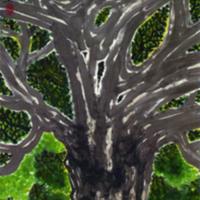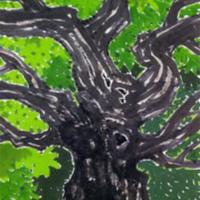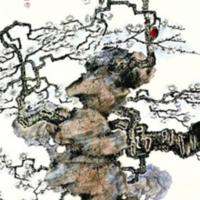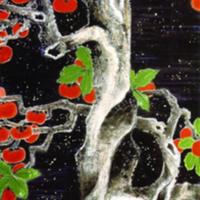Internal Change: Contemporaneity and Nonhuman Time
Thinking and picturing the Anthropocene inevitably involves a great effort to think and reconcile different temporalities: inner and outer, human and nonhuman, urban and rural, localized and global. Indeed, the Anthropocene must be thought in conjunction with the question of the contemporary, in which diverse global times coexist and are structured by enterprises like art, which assemble and disperse meaning and meaning-structures.[1] Lo Ch'ing's art operates in the peculiar nexus created between the Anthropocene and notions of tradition, postmodernity, and contemporaneity, all of which bring their own models of historical and artistic time.
On the one hand, Lo's art is steeped in the continuity of tradition, but it also draws our attention to the Western etymology of the term 'tradition,' which shares its roots with 'betrayal.' Even as Lo's poetry and paintings develop out of long histories of linguistic and artistic practice, they also simultaneously give these traditions over to a new world. They undermine tradition as much as they reinforce it, and at the same time they undermine prevailing beliefs about our modern world as much as they embrace the novelty of our 20th and 21st-century existence. Alongside Lo's dialectical play on and with tradition stands his postmodern tendencies, which have already been discussed. Finally, the question of Lo's contemporaneity demands that we try to understand his work in terms of the clash and the mutual dependency of a number of different models of time and duration. This question is raised in the artist's animal paintings, but even more directly in his works dealing with fruits, flowers, and the contrast between the city and the forests.
Part of the significance of Lo Ch'ing's engagement with the nonhuman (and specifically with animals and plants) involves an interest in a world beyond mere semiotic play—a world in which the interplay of technology and nature has consequences that exceed the interplay of signs. However, it is also the case that writing and the sign are an important part of both Lo Ch'ing's appropriation of the Chinese tradition in poetry and painting and his engagement with Western post-structuralist theory.[2] Lo Ch'ing's interest in writing and its postmodern possibilities, as a practice that is deeply significant to both Eastern and Western philosophies and artistic traditions, is always already an interest in the nonhuman and its relationship to the human.
The time of the nonhuman is obviously not homogenous; there is no question of recovering from our surroundings the dialectical Other of our own durational experience or rationalist chronology, and then performing a synthetic operation that would show that we all 'share' the same time. Rather, opening ourselves to the times of other beings involves letting go the search for a stable typology of temporality. It also involves freeing ourselves from certain persistent associations between the passage of time and apparent phenomena. Let us briefly consider Lo Ch'ing's own analysis of time as expressed in Song Dynasty painting, as a bridge that will bring us closer to the manifestations of time in the artist's own works. Lo Ch'ing recounts Shen Kuan's (1030-1094) anecdote called "On Peonies," which I quote at length:
Minister O-yang brought an old painting called 'Peonies' in which a cat was painted under the flowers. He wanted to have a specialist evaluate it. Prime Minister Wu Cheng-ssu, a relative through marriage of O-yang, viewed it and commented: 'These are noontime peonies. How can I be sure? The petals of the flowers droop and their color is dry; these are indeed the signs of noontime flowers. Furthermore, the dark round pupils of the cat turn into lines which prove that they are the pupils of a cat at noontime.' [3]
Lo Ch'ing explains that this passage reveals that the aim of the Chinese painter is to show "the internal rather than the external relationship between time and the object. …[T]ime is not only an activator of the changes of light and shade upon the object, but most of all it is a dominant factor of internal change."[4] Lo Ch'ing attributes this temporal framework, in part, to the structure of the Chinese language itself,[5] but we can also see the ramifications of this alternative view of time in relation to nonhuman entanglement. Rather than picturing time straightforwardly in terms of human perceptive apparatuses (as 'changes of light and shade'), the tradition of Chinese painting can urge us to consider less qualitatively visible aspects of change: growth, decay, the obscure becoming of the nonhuman according to cycles and interruptions that extend beyond the realm of our knowledge and teleologies.
As philosopher Michael Marder has pointed out, the life cycle of the plant—"[g]ermination and growth, flourishing, dehiscence, blossoming, coming to fruition, and finally fermentation and decay"— has often been taken (by Western philosophers) as emblematic of temporalization writ large on nature.[6] The seeming universality of vegetal cycles, however, is always squared against the apparently complete passivity of the plant, which is at once representative of the passage of time and at the mercy of external temporal changes (the seasons, daylight, etc.). Thus, Marder argues, the time of the plant is a hetero-temporality, developing out of the deconstructive difference between the plant body's growth and the dissemination of the seed. It is also fundamentally "the time of the other," since all growth comes about from the influence of external factors (sun, water, minerals, and so forth).[7] In fact, the plant's temporal disparity does not reinforce the simple dichotomy of inside/outside; instead, it invites us to consider a heterogeneous time (of growth, of action, of decay) that is not simplistically divided into an inner (subject) and an outer (object). The inner itself becomes heterogeneous, and is (dis)/continuous with the outer.
Works like The Coming and Going of the Cities (2009) and Once the World's Highest Tower (2009) juxtapose the time of flora to the time of human artifice, to the bustling speed and development of the city, modernity's icon. The flux of the city, here, is imagined as a cyclical movement more akin to that of the seasons. This cycle is juxtaposed with the deep time of trees, which both perdure beyond and are exceeded by the growth of the city. In these works, the skyline of the city along the lower edge of the paintings serves as the background, and the tree becomes the lone protagonist of the composition—its gnarled truck and abundant foliage fill the field of view. The tree itself, however, introduces its own multiple temporalities, as Marder's analysis above makes clear. The tree, a function of both its rootedness in the nourishing surface of the earth and its constant upward and outward growth towards the sun, presents us with a model of an entity fixed between two times. Furthermore, the tree models both interior and exterior time. Its leaves change color and fall away, its bark becomes more wrinkled and rough, and its branches twist and reach. All of these signs, however, also refer to internal transformations, ones that cannot be imaged by the Western (Renaissance) model of depicting the play of (sun)light and shadow over surface.[8]
The time of flora draws our attention not only to the invisible aspects of growth—which coexist with the speed of postmodern life and the cycles of phenomena like the seasons—but also to blossoming and fruition. Lo Ch'ing addresses these ideas, which suggest the coming-to-fullness of time in the world, in works like Things Will Be Ripe Like Persimmons When Time Comes (2006). The ripening of the fruit as a metaphor for human development has a long history, and here Lo Ch'ing seems to extend this metaphor to all things: time becomes a uniting, homogeneous state expressed visually in the bright red skin of the persimmons. (Here again exterior appearances point to the underlying effects and processes of time.) Simultaneously, time itself is envisioned as anticipatory: things wait for the arrival of ripeness, of fullness, of completion. This anticipatory structure emphasizes the fundamental open-endedness of the contemporary moment: the future is still undecided, and our actions in the present may reconcile our time with that of the nonhuman world, or we may continue to multiply the disjunctures between human and nonhuman times.
[1] For two discussions of the possible definitions of contemporary art, considered from a critical perspective, see Peter Osborne, Anywhere or Not At All: Philosophy of Contemporary Art (New York: Verso, 2013), and Terry Smith, What is Contemporary Art? (Chicago: University of Chicago Press, 2009).
[2] It should be noted that Lo Ch'ing's engagement with post-structuralist thought is sustained: he has both lectured on the work of authors like Foucault and Derrida and translated the writing of Lyotard. See Olivia Sand, "Profile: Lo Ch'ing," Asian Art Newspaper, October 2014, 6.
[3] Qtd. in Lo Ch'ing, "The Chinese Language and Chinese Landscape Painting," Studies in English Literature and Linguistics (May 1987): 96.
[4] Lo Ch'ing, "The Chinese Language and Chinese Landscape Painting," 96.
[5] Ibid., 95.
[6] Michael Marder, Plant-Thinking: A Philosophy of Vegetal Life (New York: Columbia University Press, 2013), 94.
[7] Ibid., 101.
[8] See the interview with Lo Ch'ing conducted in association with this exhibition.



